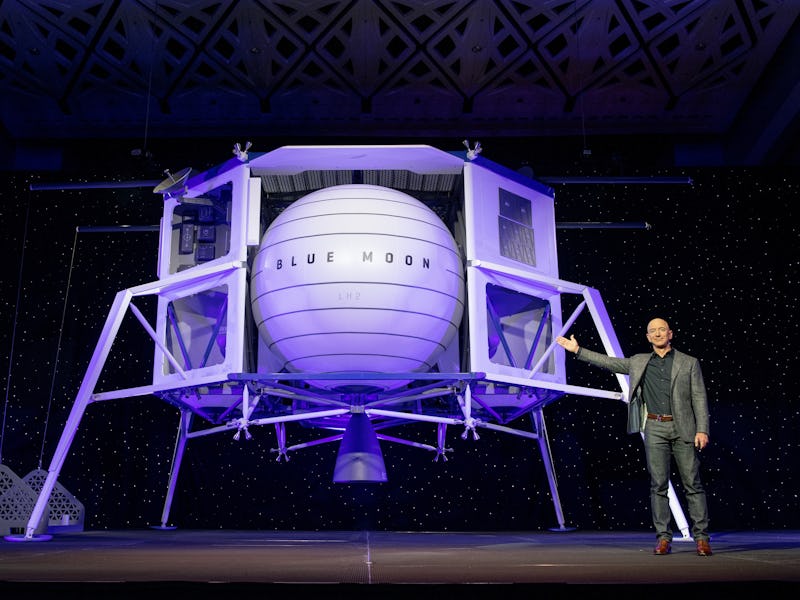New Space Race? SpaceX and Blue Origin Could Compete to Send Humans to Moon
The return to the moon could come sooner than expected.

Who will be the next person to step on the moon? If a new competition comes to light, it could be an astronaut recruited by SpaceX or Blue Origin.
A team of officials is reportedly pressing president Donald Trump to create a $2 billion prize to the first company able to establish a base on the moon. The proposal, reported by Politico Monday, is being pushed by the former Republican speaker of the house Newt Gingrich among others. The idea could bypass a similar plan by NASA that’s expected to cost over $50 billion and reach the moon by 2024.
“This is a great idea,” Elon Musk, CEO of SpaceX, stated via Twitter Tuesday morning.
If the project comes to light, it could add fuel to an emerging new space race driven by the private sector. This new race includes the likes of SpaceX and Blue Origin, the latter of which was founded by Amazon CEO and world’s richest man Jeff Bezos. It’s a race that’s seen SpaceX build reusable rockets, Blue Origin debut a reusable space capsule, and Virgin Galactic break new ground in weightlessness.
These firms have far-flung ambitions, complete with eye-catching concept art. Musk gushes about a city on Mars turning humans into an interplanetary species, while Bezos waxes lyrical about finding the next Mozart in a trillion-strong floating space colony. A race to get to the moon first could give these plans a big boost.
New Space Race: SpaceX and Blue Origin Step Up
The Gingrich proposal is early days, and bar a warm Twitter post from Musk, it’s uncertain which firms would take up the challenge if it came to fruition. However, both SpaceX and Blue Origin have been locked in a lunar battle that suggests they would be particularly warm to the idea.
Blue Origin unveiled its design for the Blue Moon lunar lander back in May 2019. One variant of the design is stretchable, capable of moving 6.5 metric tones in a human-rated ascent stage. It uses a BE-7 engine that burns liquid hydrogen and oxygen, which means it could refuel on the moon, to deliver 10,000 pounds of thrust. Bezos claims the lander could help humans walk on the moon by 2024.
“This is an incredible vehicle, and it’s going to the moon,” Bezos said at the launch. He also explained how it builds on the New Shepard suborbital rocket and New Glenn successor.
SpaceX is currently developing the Starship, an all-purpose vehicle designed to send the first humans to Mars. Its Raptor engines use liquid oxygen and methane, which also enables refueling on other planets. The design is currently under development at the Boca Chica facility in Texas, with a presentation on progress expected later this month.
Musk, who plans to send a team of artists around the moon in 2023, stated in March that landing humans on the surface by 2024 could be possible.
“Would be great to have a competitive, commercial program to build a moon base that is outcome-oriented (not cost-plus), so you only get paid for safe delivery of cargo,” Musk wrote.
SpaceX Starship on the moon.
New Space Race: Why NASA Could Fall Behind
NASA aims to send humans to the moon as early as 2024, just five years from now. But the Gingrich-pushed proposal is critical of NASA’s efforts to return to the moon.
The agency would use space contractors like Lockheed Martin and Boeing, firms that advocates for commercially-driven space launches criticize for their high costs. Rick Tumlinson, founder of the SpaceFund venture capital firm and one such advocate, told Inverse in February how the agency’s contracts with these firms could push up prices:
Cost-plus contracting is how you get military jets that cost millions of dollars: If you, the government, want me, the contractor, to build you a flashlight, I get to charge you 10 percent of whatever it cost me to develop. Why would I sell to you for $10 and keep $1 when I can charge you $1 million and keep $100,000?
At a Morgan Stanley space summit in December 2018, 10 out of 12 space experts predicted China would beat the United States in sending a human to the moon, as the China National Space Administration journeyed to the dark side of the moon with the Chang’e-4 probe.
“In the next one to two decades, we will definitely see a Chinese astronaut landing on the Moon,” Christoph Beischl, a researcher at the London Institute of Space Policy and Law, told Nature.
Concept art of Boeing and NASA's SLS.
Amid this competition from China, people involved in the Gingrich plan are unsure whether NASA could even meet the 2024 deadline. The agency’s plan relies on the Space Launch System, a Boeing-built rocket with ballooning costs that reached $24 billion in 2018. The upcoming mission is also designed to support a more permanent presence on the moon, moving back and forth between a gateway. These factors and more are why the only organization to land a human on the moon may struggle to do it again so soon.
“Right now, China is on a path to [have a moon settlement] in 20 years, and we are on a path to be there in 50 years,” Air Force lieutenant general Steven Kwast, a co-author of the Gingrich plan, told Politico. “We are not aggressive about it. We have the wrong strategy, the wrong ideas, the wrong doctrine. We are trapped in an industrial age model of thinking about space.”